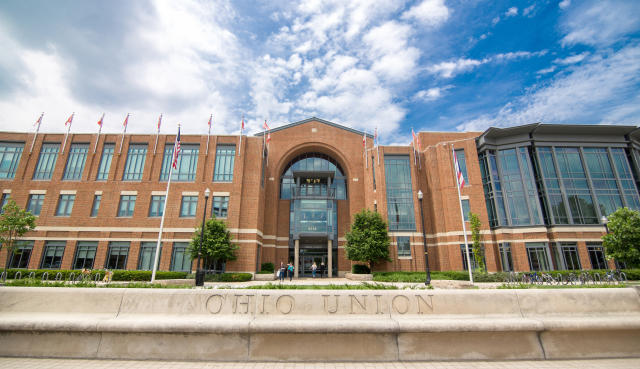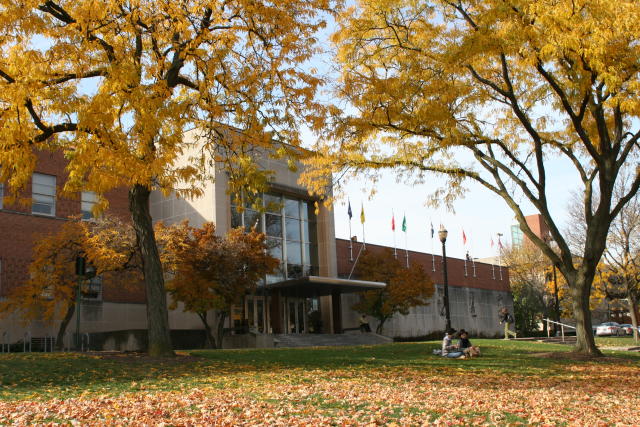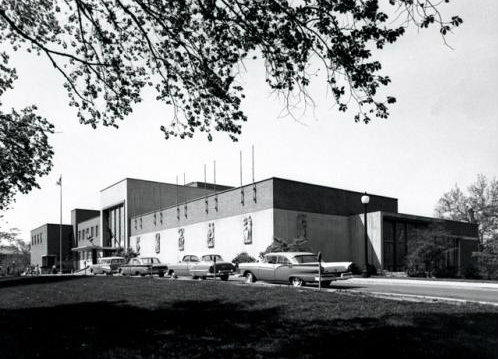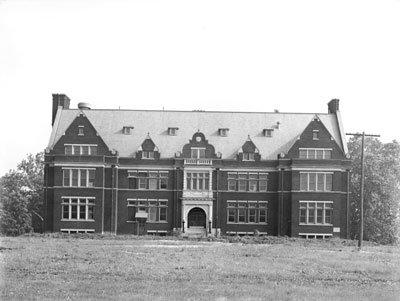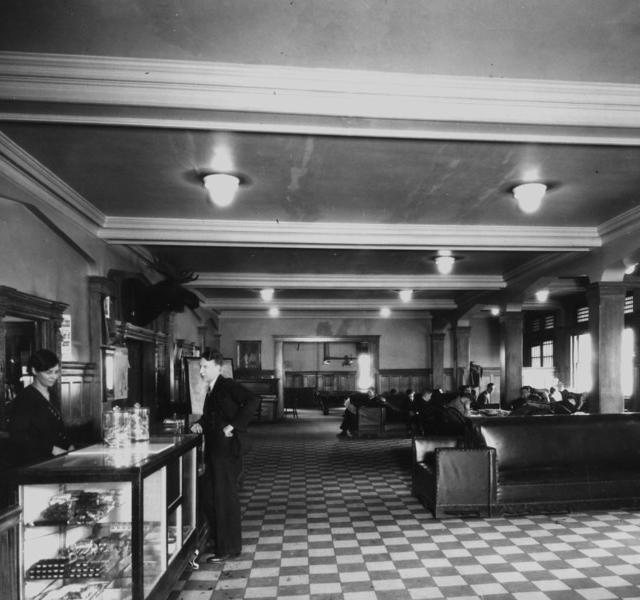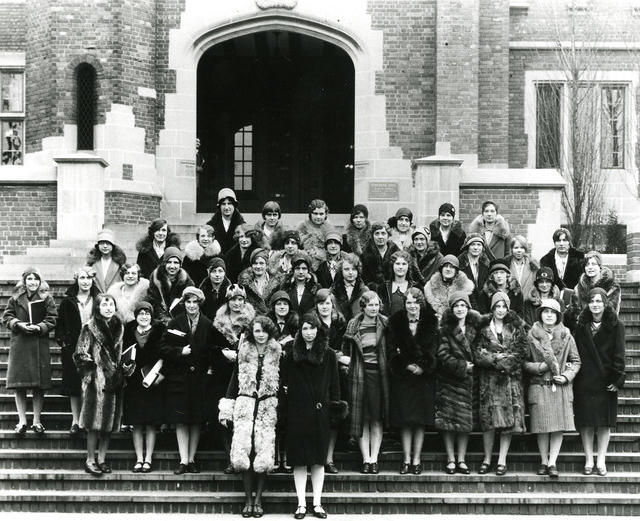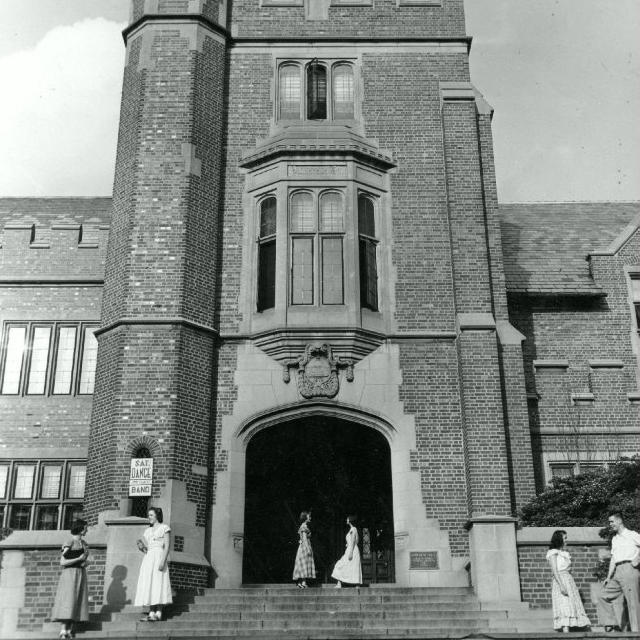History
In 1908, Aaron Cohn, now known as the Father of the Ohio Union, led a campaign for the creation of a student focused building. This became the catalyst for the movement to create a student union. Although the building that wears the name 'Ohio Union' has changed, the mission to serve as a central hub for student life and support has not.
The Ohio Union (2010 - present)
The planning and construction of the present Ohio Union was heavily influenced by the student body. As early as October 2002, students, staff, faculty and consultants began their involvement in the support and design for a Union. Countless students participated in each phase of construction. A group of students visited student unions across the country to determine what type of union to construct. This experience also helped students realize that a student union fee was necessary to support the activities of a new union, which the student government councils supported.
Students played an extremely integral role in each phase of the Union's construction. They voted on color schemes, tested what furniture would be used and even worked closely with the architects to help design the ideal study spaces.
Ohio State has a commitment to sustainability, and partnered with Habitat For Humanity to help with the deconstruction of the old Ohio Union. The parts that we still useful were all donated to Habitat For Humanity for sale at their 'Build It Again' center. The parts that were recovered were worth a whopping $40,000.
The new Union is a beautiful culmination of both art and functionality. It inspires The Ohio State University's population to 'do something great.'
2017-2018
- Jeff Pelletier, Director of Ohio Union Operations and Events, served as the president of the Association of College Unions International. The Role of the College Union Statement is revised, updating the work of Pelletier's predecessor, Fred Stecker, over 50 years earlier.
2015
- A celebration for the first College Football Playoff champion Ohio State Buckeyes takes place in the Great Hall. This marks the football team's eigth national championship.
- Governor John Kasich announces his bid for the national presidency in the Great Hall of the Ohio Union.
2014
- The Ohio Union hosts events commemorating the university's 15th President, Dr. Michael V. Drake.
2011
- In November, following a years-long process of restructuring multiple departments in the Office of Student Life, Eve Esch is named Director of Events, and Matt Couch is named Director of Student Activities.
2010
- The New Ohio Union opens at the start of Spring quarter.
2009
- The Bronze bust of Beanie Drake is poured.
- Plank Signing Ceremony- Signed floorboards installed in Woody's Tavern.
2008
- Topping Ceremony- The last piece of steel is placed at the highest point of the building.
2007
- Smudging Ceremony on January 22.
- Ohio Union Offices and staff relocated prior to demolition.
- Demolition of existing Ohio Union/Construction begins on January 31.
- Building Raising Ceremony on November 30.
The Ohio Union (1951-2007)
In January of 1947, a movement was made by the students. They petitioned for a new Ohio Union that allowed men and women equal access. They were so passionate about the construction of this new building that the students themselves contributed not only to ideas for the new union, but also to the cost.
The construction of this student 'Dream Union' started in June of 1949. When the building was completed in 1951, it was home to a cafeteria, a lovely terrace dining room, two spacious ballrooms, a browsing library, a music lounge, 18 pool tables, a 16 lane bowling alley and 19 offices for use by student organizations.
Remembered as 'a place to learn the social graces in life' by Wendell Ellenwood (Director 1958-83), the Union adapted its services through the years to accommodate the changing needs of students. During the 1960s and early 1970s, the Union worked to service students during an era of turmoil and protesting. At the Union's 75th anniversary celebration, John Ellinger (Director 1983-88) said 'today's students are looking for more from us.' To meet expectations, a free micro-computer lab was opened in 1985 at the Union and was described as 'a much needed service for the OSU community' by David Mucci (Director 1988-93).
As time went on, the success of the Union made it difficult to maintain the facility and the Union's charm began to fade. A 1986 study concluded that $10 million would need to be spent by 1994 to maintain the plumbing, roofing, and heating systems.
Up until 1960, men were required to take their hats off prior to entering the union.
Plans for renovating the Union were drawn up in 1994, however the proposal was defeated in a student referendum in 1995. If a new Union was to be built, support from the student body would be a key factor; just as it had been in the past.
Unable to address the facility's structural inadequacies, Rebecca Parker (Director 1994-2001) focused on programming at the Union. Tracy Stuck (Director since 2001) merged the Office of Student Activities with the Ohio Union staff to support the Union's mission of providing students with the best services and activities. Stuck also brought a Buckeye theme back to the building by making aesthetic changes and adding scarlet and gray into the décor. Despite the improvement, the building still looked outdated.
During the 2003-2004 academic year, Ohio State's three student governments rallied support to successfully campaign for a new Union. Joining the students' efforts, the Union staff presented a 'road-show' exhibit to student organizations, residence halls and anyone who was interested in learning more about a new Ohio Union.
By June 2004, the Board of Trustees approved plans to demolish the building and construct a new Union on the same site. The 1951 Union demolition was completed in 2007. The month after tearing down the old Ohio Union, the current Ohio Union construction started.
2005
- February 28, there is a planning committee kickoff
- Committee members tour Carnegie Mellon Student Center in March.
- Committee members tour Bowling Green State University and University of Michigan, April 8.
- Committee members tour Penn State University a few days later, April 11.
- Committee members tour University of Arizonia union on April 18.
- Committee members tour Colorado State and University of Colorado April 19.
- May 3 is a student dinner presentation.
- There is a LEED/Sustainable Workshop in July.
- Core Group trip to Ohio University in late September.
- Multi-Cultural plan work session in November.
- Junk Party on July 10.
- AV Technology workshop in early August.
- The Student Farewell Dinner on November 29.
- Another Junk Party on December 5.
- The Faculty/Staff/Alumni Farewell Lunch
- December 8 is the last day vendors were open.
- December 22 is the last day 5/3rd Bank was open.
2004
- In October, focus group sessions are held.
- Board of Trustees approves the new Ohio Union Project in June.
- In September, Moody Nolan is selected as Architect of Record.
- The Edge Group (owned by Eddie George) is hired as the Landscape Architect.
2002
- Ohio Union office is being renovated, as it is the first project to remove remaining asbestos from the building.
2001
- Creative Activities Program (CAP) saw a reduction in the number of attendees and programs so in March of 2001 was decided to disband the program due to declining enrollments and revenue.
- After a feasibility study conducted by a consulting group, it was decided to close the Ohio Union catering operation, Applause Catering, in July. Catering was suffering financial difficulties and was looking to restructure its operation. However, without a major renovation of the kitchen, the food service area would continue to have operational inefficiencies which would continue to result in budget shortfalls.
- Bill Hall was named the new Vice President of Student Affairs and restructured the division of Student Affairs. The Ohio Union and Student Activities were merged into one department. Tracy Stuck, former Director of Student Activities was named the Director of Ohio Union.
- Becky Parker, former Ohio Union director left the University for a position at Bank One.
2000
- Rebecca Parker was named Assistant Vice President for Student Affairs and Director of the Ohio Union. As the Assistant VP, she oversaw the Student Activities office, Student Gender and Sexuality Services and Ethnic Student Services.
1999
- The Ohio Union gave the Student Activities office the following programs to operate: Forensics, CAP and the Ohio Union Activities Board (OUAB).
1997
- The Assistant Director of the Ohio Unions, for Campus Programs and Events position was abolished as a result of a reorganization of the Student Life department, within the Division of Student Affairs. This position originated in 1927 before a developed Student Affairs division was in place, and the union was the primary facilitator of campus programming.
1996
- The Ohio Unions staff and University administration agreed to renovate the Ohio Union with administrative dollars. Not enough money was able to be secured to renovate so the plan was abolished.
1995
- A student referendum defeated the vote for a new union to be financed by student dollars.
1994
- Rebecca Parker began as the Director of the Ohio Unions, after serving for 17 years in the Office of Residence and Dining Halls with the last postion as Associate Director of Residence and Dining Halls, for Residence Life.
1993
- David Mucci left the Ohio Unions to serve as the Director of the student union at the University of Idaho. Susan Henderson served as the Acting Director of the Ohio Unions, after serving as the Business Manager with David Mucci.
1991
- Discussions began in the Division of Student Affairs about the construction of a new student union. The Ohio/Drake Union Activities Board was renamed the Student Events Committee (SEC).
1989
- The 75th Anniversary of the Association of College Unions International was held at the Ohio State University. John Ellinger served as the chair of the Host Committee.
1988
- John Ellinger left the Ohio Unions to serve as the Assistant Vice President for the College of Agriculture. David Mucci became the Director of the Ohio Unions, after serving as the Associate Director with John Ellinger.
1986
- An external engineering study was conducted to provide the basis of support for increased University funding and future renovation.
1985
- The Ohio Union began catering services with off-site events. PERKS was created. External earnings and contracts surpassed internal earnings and the support of the University.
1984
- A frozen pipe burst the day after Christmas, flooding the lower levels and creating $300,000 in damage. The staff was called in to help clean up the mess.
1983
- Wendell Ellenwood retired as the Director of the Ohio Unions, after 25 years of service. John Ellinger became the Director of the Ohio Unions, after serving as Associate Director with Wendell Ellenwood.
1982
- The Main and Stecker lounges were renovated for the first time since 1962. The first Wendell Ellenwood Scholarship was presented.
1981
- The Ohio Union's alumni raised over $26,000 to start the Wendell Ellenwood Scholarship Fund.
1978
- The Ohio Union's Alumni Society was formed.
1977
- Robbin Kirkland was hired as the first full-time Assistant Director for Drake Union.
1972
- The Drake Union opened. Named in honor of Edward S. Drake, this union was built for $4,500,000 to serve the needs of the students in the west campus areas. The original design for the Drake Union placed it on the bridge, connecting towers that were to be on both sides of the Olentangy River
- Ohio Union Activities was changed to Ohio/Drake Union Activities (ODUA).
1970
- The Ohio Union began to suffer financial losses, as the campus continued to grow, and the culture began to change. With the opening of the Fawcett Center, the Ohio Union lost a significant portion of its conference business. Simultaneously, as fast food became more popular on High Street, the cafeteria-style food service offered in the union began its decline. Prior to this time, the food service operation could support student programming. These changes made that income source impossible. Nonetheless, the union remained a gathering place for students. When the university closed in response to the 1970 riots, the Ohio Union remained open.
1967
- The Creative Activities Program (CAP) started as a volunteer project.
1966
- The OSU Football Training Table came to the Ohio Union, where it remained until 1992. Woody Hayes originally negotiated this arrangement with Wendell Ellenwood, to help provide the team with the social graces they needed for their VIP visits, receptions, dinners, etc.
- Beanie Drake died on March 23.
1964
- The Ohio Union Art Collection began.
1963
- The Edward S. Drake Student Leadership Endowment Fund was established.
1962
- The South Terrace was enclosed, and used primarily to provide meal service for the students of Steeb Hall.
- A fourth floor was built onto the Ohio Union to house the Dean of Students Office.
1960
- The Ohio Union celebrated its 50th year anniversary, among guests including a former governor, college and university presidents, faculty, school superintendents, teachers, corporate presidents, playwrights, authors, actors, and students.
1959
- At a fall meeting of the University Board of Trustees, the Ohio Union Council was established with 16 members (8 students and 8 non-students).
1958
- Wendell Ellenwood was appointed as Director of the Ohio Union, after Fred Stecker accepted a position with the new university president, Novice Fawcett, as Executive Director for University Relations. With the original cost of the new union largely paid off, attention was turned to the need for funds to maintain and refurbish the building. The Board of Trustees approved a change making the original Ohio Union Building Fund a Student Services Facility Fee and provided that these funds be used for facilities benefiting the students of the university. Funds were made available at that time for the continual maintenance of the Ohio Union in "like new" condition.
1955
- Fred Stecker served as the president of the Association of College Unions. Under Stecker's leadership, "The Role of the College Union" was developed. Porter Butts from the University of Wisconsin, and Edgar Whiting from Cornell University also played significant roles in authoring this statement. Today, the Butts-Whiting award is the highest honor of achievement given by the Association of College Unions International.
1953
- Dates and Data, sponsored entirely by the student programming board called Ohio Unions Activities, was first published.
1951
- The new student union was dedicated on November 17, and was considered a model for the country.
Hale Hall (1910-1951)
Through the overwhelming support generated through the 77th Ohio General Assembly, $75,000 was appropriated to be used for the construction of the student union. This new building was officially named 'the Ohio Union' on October 29, 1909 and opened in 1910. The Ohio Union was the first student union at a public university.
After the Ohio Union opened, the student council created a board of overseers in charge of making sure the building activities ran smoothly. Membership dues were charged to only male students in order to raise funds for building maintenance. The small percentage of women who were enrolled in the University were only allowed to use the building once a week on 'Ladies Day.'
The Ohio Union was, and still is, utilized by many different student organizations. Dinners, banquets, conventions and other events are held at the Union. In the 1913-1914 academic year, the Union hosted 415 meetings, 256 banquets and 37 dances.
During World War I, the Ohio Union served as a mess hall and social center for the troops quartered on campus.
Edward S. 'Beanie' Drake was hired as the manager of the Union in 1913. He dedicated much of his time and energy to student organizations such as: Phi Sigma Kappa, Romophos, Bucket and Dipper, Sphinx and Ohio Staters.
The Union played a special role in the construction of the Ohio Stadium. In 1921, the Union dedicated its entire second floor as a work space for the stadium building committee. It promised to "do everything in its power to assure the success" of the stadium project.
Enarson Hall was almost torn down in 1951, but was saved as a historical landmark. In 2013, Enarson Hall was named Hale Hall, after Dr. Frank W. Hale, Jr. and the Central Classroom Building was renamed Enarson Classroom Building.
Pomerene Hall (1922-1951)
The Women's Building
Due to the small proportion of women attending the University in the early 1900s, only a simple room in University Hall served as women's social center. This room, nicknamed the 'Gab Room, was maintained by the Women's Council using a 25 cent annual membership fee.
As women became more prominent on the University campus, it was soon recognized that a single 'Gab Room' was not enough space to accommodate the growing women's population. In 1917 the Women's Council appeared before the board of trustees and sought money for the construction of a women's building.
The board of trustees, believing it only appropriate to allocate budgeted money to academic buildings, advised the women to appeal to the University legislature to request money for their building.
The campaign was successful and $150,000 was allocated for the construction of a women's building. However, the production of the building was postponed because of a University ban that prohibited building projects until after World War I was over. After the war, another $90,000 was appropriated to the original allocation of $150,000.
The $240,000 allocated to the Women's Building was deemed insufficient for the complete construction. It was decided that the structure would be built in two phases. In 1919 the first phase of construction was completed. It included the gymnasium, as well as the social center. In 1927 the building was finally completed. Named Pomerene Hall, it included the indoor swimming pool, lounges, kitchen and cafeteria.
1949
- Construction began on a new union.
1947
- The Student Senate collected the signatures of 14,000 students in favor of paying $5 per quarter to pay for the building costs of a new union. At the Board of Trustees Meeting on June 30, President Bevis announced this as a "going project."
1946
- Beanie Drake retired as the manager of the Ohio Union, after serving 33 years. On March 11, Frederick J. Stecker was elected to serve as the manager of the Ohio Union.
- President Bevis urged the formation of student committees to work with the Ohio Union Board of overseers to plan a new union.
1945
- The women opened the lounges of Pomerene Hall to men. On February 13, the men voted to open the lounges of the Ohio Union to women.
1939
- When it became apparent that a newly constructed building was not in the immediate future, it was renovated and refurbished for $35,000.
1938
- The Student Senate began to accumulate a Union Building Fund by setting aside a percentage of profits from dances.
1935
- The Student Senate identified the need for coordinated scheduling of campus events. The Unions Activities Office assumed this responsibility.
1933
- Beanie Drake served as the president of the Association of College Unions. During his term, guest speakers were included at the annual conference for the first time, to discuss trends of college life and work. The first collegiate billiards tournament was also established.
1927
- The position of Activities Director for the Ohio Unions was created in response to the growing number of students working on an increasing number of union sponsored programs. Simultaneously, three committees were added to the Board: Social, Publicity & Art, and Music & Library.
1926
- Discussion about the construction of a new student union - one for both men and women - began.
1924
- Pomerene Hall was built as the women's union.
1916
- The Ohio State University hosted the 2nd annual conference of The National Association of Student Unions.
1915
- Beanie Drake served as the Secretary of the National Association of Student Unions until 1933.
1914
- The Ohio State University, through Beanie Drake, initiated a discussion among representatives of other college unions. This was the beginning of The Association of College Unions.
1913
- Edward S. (Beanie) Drake was named manager of the Ohio Union.
1911
- Ohio Unions managed by Board of Overseers.
- President of Board, student.
- Secretary of Board, manager of Ohio Unions.
1909
- Cornerstone for First Ohio Union (now Hale Hall) laid.

